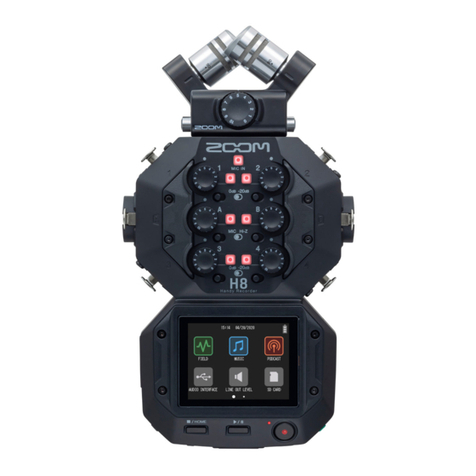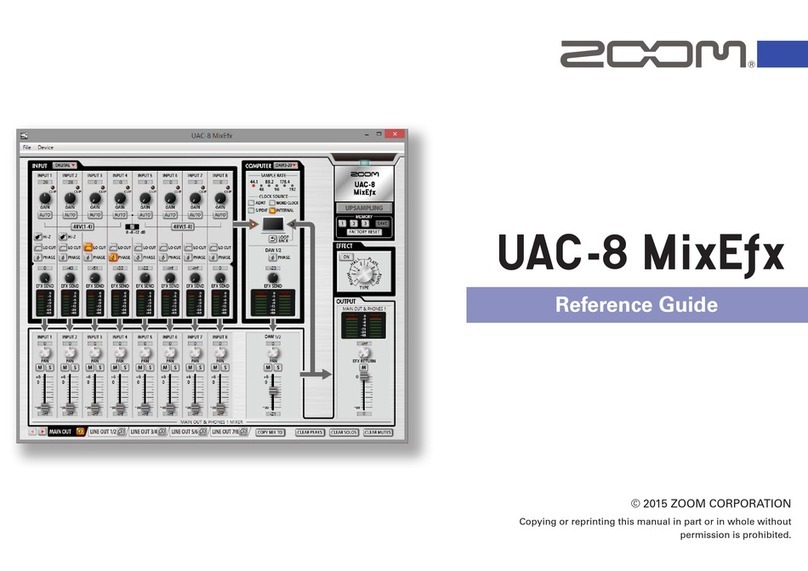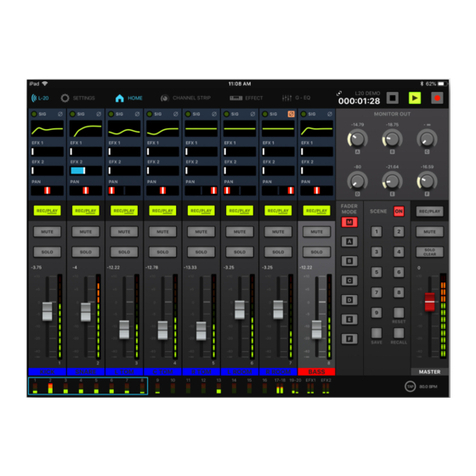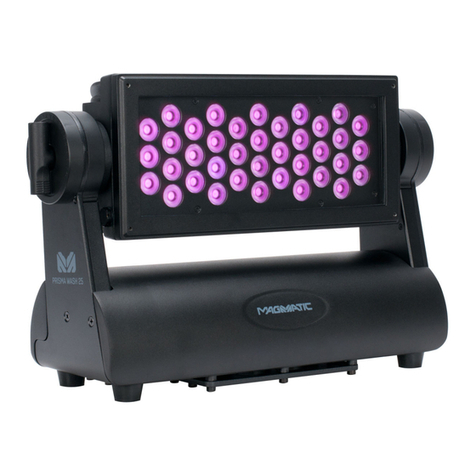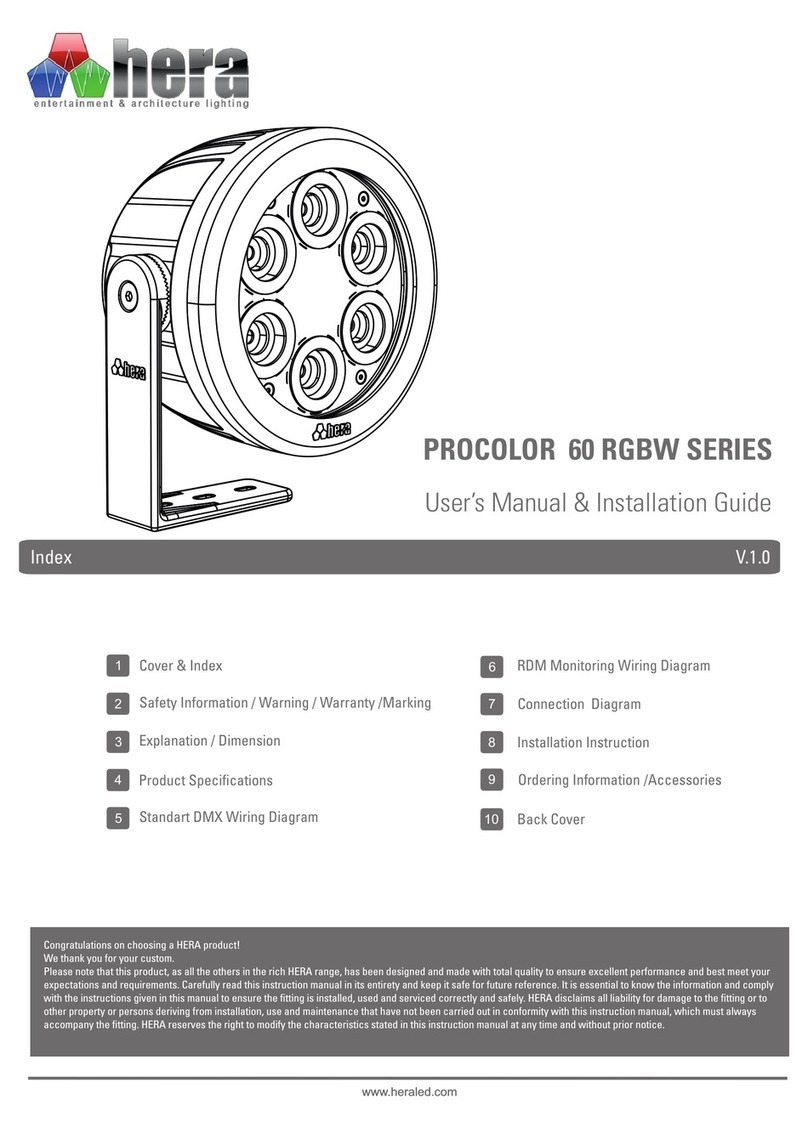Zoom ARQ AR-96 Installation guide

Aero RhythmTrak
A
Quick Manual
© 2016 ZOOM CORPORATION
Copying or reprinting this manual in part or in whole without permission is prohibited.
The Operation Manual can be downloaded from the ZOOM website (www.zoom.co.jp)

Usage and Safety Precautions .......................3
Introduction ...................................................6
Explanation of terms ......................................7
Overview
Names of parts ..............................................8
Using the A....................................... 11
Ring Controller overview ..............................12
Connecting other devices ............................14
Switching modes .........................................15
Instrument overview.....................................16
Preparations
Turning the power on and o .......................17
Loading an SD card..................................... 19
INST mode
INST mode overview....................................20
Operation procedure....................................21
STEP mode
STEP mode overview...................................23
Operation procedure....................................25
SONG mode
SONG mode overview .................................26
Operation procedure....................................27
Capturing audio (recording)
Capture overview.........................................28
Operation procedure....................................29
LOOPER mode
LOOPER mode overview .............................30
Operation procedure....................................31
Other functions
Editing sounds.............................................32
Eects .........................................................32
Mixer ...........................................................32
Troubleshooting ...........................................33
Specications ..............................................34
Contents

3
Safety Precautions
In this Quick Manual, symbols are used to highlight
warnings and cautions that you must read to prevent
accidents. The meanings of these symbols are as
follows.
Something that could cause serious
injury or death
Something that could cause injury or
damage to the equipment
Other symbols used
An action that is mandatory
An action that is prohibited
Warning
Operation using an AC adapter
Never use any AC adapter other than a ZOOM AD-
14. The use of other than the specied type could
damage the unit and pose a safety hazard.
Connect the AC adapter only to an AC outlet that
supplies the rated voltage required by the adapter.
Operation using the rechargeable battery
Always use a ZOOM BT-04 rechargeable battery.
Carefully study warning indications on batteries
before use.
Always keep the battery cover closed during use.
Alterations
Do not open the case or modify the product.
Caution
Product handling
Do not drop, bump or apply excessive force to the
unit.
Be careful not to allow foreign objects or liquids to
enter the unit.
Operating environment
Do not use in extremely high or low temperatures.
Do not use near heaters, stoves and other heat
sources.
Do not use in very high humidity or where it could
be splashed by water.
Do not use in places with frequent vibrations.
Do not use in places with much dust or sand.
AC adapter handling
When disconnecting the power plug from an out-
let, always pull on the plug itself.
Disconnect the power plug from the outlet when
the unit will not be used for a long time and when-
ever there is lightning.
Connection cables and input/output jacks
Always turn the power OFF for all equipment be-
fore connecting any cables.
Always disconnect all connection cables and the
AC adapter before moving the unit.
Volume
Do not use at a loud volume for a long time.
Usage Precautions
Interference with other electrical equipment
In consideration of safety, the Ahas been de-
signed to minimize its emission of electromagnetic
waves and to suppress interference from external
electromagnetic waves. However, equipment that is
very susceptible to interference or that emits power-
ful electromagnetic waves could result in interference
if placed nearby. If this occurs, place the Aand
the other device farther apart.
With any type of electronic device that uses digital
control, including the A, electromagnetic inter-
ference could cause malfunction, corrupt or destroy
data and result in other unexpected trouble. Always
use caution.
Cleaning
Use a soft cloth to clean the exterior of the unit if it
becomes dirty. If necessary, use a damp cloth that
has been wrung out well to wipe it.
If the Ring Controller surface becomes dirty, wipe it
with a soft damp cloth that does not shed bers.
Never use abrasive cleansers, wax or solvents such
as alcohol, benzene or paint thinner.
Breakdown and malfunction
If the unit becomes broken or malfunctions, imme-
diately disconnect the AC adapter, turn the power
off and disconnect other cables. Contact the store
where you bought the unit or ZOOM service with the
following information: product model, serial number
and specic symptoms of breakdown or malfunction,
along with your name, address and telephone num-
ber.
Usage and Safety Precautions

4
Copyrights
• Windows®, Windows®10, Windows®8 and Win-
dows®7 are trademarks or registered trademarks of
Microsoft®Corporation.
• Mac, Mac OS, iPad and iOS are trademarks or reg-
istered trademarks of Apple Inc.
• Intel and Intel Core are trademarks or registered
trademarks of Intel Corporation or its subsidiaries
in the US and other countries.
• The SD, SDHC and SDXC logos are trademarks.
• Bluetooth and the Bluetooth logo are registered
trademarks of Bluetooth SIG, Inc. and are used un-
der license by ZOOM CORPORATION.
• MIDI is a registered trademark of the Association of
Musical Electronics Industry (AMEI).
• Other product names, registered trademarks and
company names in this document are the property
of their respective companies.
Note: All trademarks and registered trademarks in this doc-
ument are for identification purposes only and are not
intended to infringe on the copyrights of their respective
owners.
Recording from copyrighted sources, including CDs, records,
tapes, live performances, video works and broadcasts, without
permission of the copyright holder for any purpose other than
personal use is prohibited by law.
ZOOM CORPORATION will not assume any responsibility re-
lated to infringements of copyrights.
For optimal performance
The Auses Bluetooth LE wireless communica-
tion for communication between the Ring Controller
and the Base Station. Communication at up to 10
meters is possible in an unobstructed indoor space.
If interference from electromagnetic waves or other
causes prevent good communication, try the follow-
ing.
• Bring the Ring Controller and the Base Station clos-
er together.
• Move any obstacles between the Ring Controller
and the Base Station.
• Stop unnecessary 2.4GHz transmissions or move
interfering devices (including the following) further
away.
• WiFi access points
• Smartphones and other devices that use WiFi
• Microwave ovens
• Audio monitors, lighting controllers and other de-
vices that communicate at 2.4GHz
Warnings and requests regarding safe
battery use
Carefully read the following warnings in order to
avoid serious injuries, burns, res and other problems
caused by leaking, heat generation, combustion, rup-
ture or accidental swallowing.
DANGER
Do not charge the lithium-ion battery (BT-04) in any
way other than using the Aand an AD-14.
Danger of explosion if battery is incorrectly re-
placed. Replace only with the same or equivalent
type.
Do not disassemble the battery, put it in fire, or
heat it in a microwave or conventional oven.
Do not leave the battery near a re, in strong sun-
light, inside a vehicle that has become hot or in
similar conditions. Do not recharge in conditions
like these.
Do not carry or store the battery with coins, hair-
pins or other metal objects.
Do not allow the battery to be wet by any liquid,
including water, seawater, milk, soft drinks or
soapy water. Do not charge or use a battery that is
wet.
Warning
Do not hit the battery with a hammer or other ob-
ject. Do not step on it or drop it. Do not otherwise
impact or apply force to the battery.
Do not use the battery if it becomes deformed or
damaged.
Do not remove or damage the outer seal. Never
use a battery that has had all or part of its outer
seal removed or a battery that has been torn.
Recycling request
Please recycle batteries to help con-
serve resources. When discarding used
batteries, always cover their terminals
and follow all laws and regulations that
are applicable to the location.
Usage and Safety Precautions (continued)

5
FCC regulation warning (for U.S.A.)
This equipment has been tested and found to
comply with the limits for a Class B digital device,
pursuant to Part 15 of the FCC Rules. These
limits are designed to provide reasonable protec-
tion against harmful interference in a residential
installation. This equipment generates, uses, and
can radiate radio frequency energy and, if not in-
stalled and used in accordance with the instruc-
tions, may cause harmful interference to radio
communications. However, there is no guarantee
that interference will not occur in a particular in-
stallation. If this equipment does cause harmful
interference to radio or television reception, which
can be determined by turning the equipment o
and on, the user is encouraged to try to correct
the interference by one or more of the following
measures:
• Reorient or relocate the receiving antenna.
• Increase the separation between the equip-
ment and receiver.
• Connect the equipment into an outlet on a
circuit different from that to which the re-
ceiver is connected.
• Consult the dealer or an experienced radio/
TV technician for help.
Disposal of Old Electrical & Electronic Equip-
ment (Applicable in European countries with
separate collection systems)
Products and batteries that
have been marked with the
symbol of a crossed-out
wheeled waste bin must not
be disposed of with household
waste.
Old electrical/electronic equip-
ment and batteries should be
recycled at facilities that are
able to process them and their
byproducts.
Contact the local government
for information about nearby
recycling facilities. Conducting
recycling and waste disposal
properly helps conserve re-
sources and prevents harmful impacts on human
health and the environment.
The contents of this document and the specications of
the product could be changed without notice.
Declaration of Conformity
For EU Countries
For U.S.A. and CANADA
This device complies with part 15 of the FCC
Rules and Industry Canada license-exempt RSS
standard(s). Operation is subject to the following
two conditions:
(1)This device may not cause harmful interference,
and (2) this device must accept any interference
received, including interference that may cause
undesired operation.
This equipment complies with FCC/IC radiation
exposure limits set forth for an uncontrolled
environment and meets the FCC radio frequency
(RF) Exposure Guidelines and RSS-102 of the
IC radio frequency (RF) Exposure rules. This
equipment has very low levels of RF energy that
are deemed to comply without testing of specific
absorption ratio (SAR).
For CANADA
Le présent appareil est conforme aux CNR
d’Industrie Canada applicables aux appareils
radio exempts de licence. L’exploitation est
autorisée aux deux conditions suivantes : (1)
l’appareil ne doit pas produire de brouillage, et
(2) l’utilisateur de l’appareil doit accepter tout
brouillage radioélectrique subi, même si le
brouillage est susceptible d’en compromettre le
fonctionnement.
Cet équipement est conforme aux limites
d’exposition aux rayonnements énoncées pour un
environnement non contrôlé et respecte les règles
d’exposition aux fréquences radioélectriques
(RF) CNR-102 de l’IC. Cet équipement émet
une énergie RF très faible qui est considérée
conforme sans évaluation du débit d’absorption
spécifique (DAS).
Label is located at the bottom of the unit.
Usage and Safety Precautions (continued)
Table of contents
Other Zoom Dj Equipment manuals
